AJS 37 Viggen SE-DXN
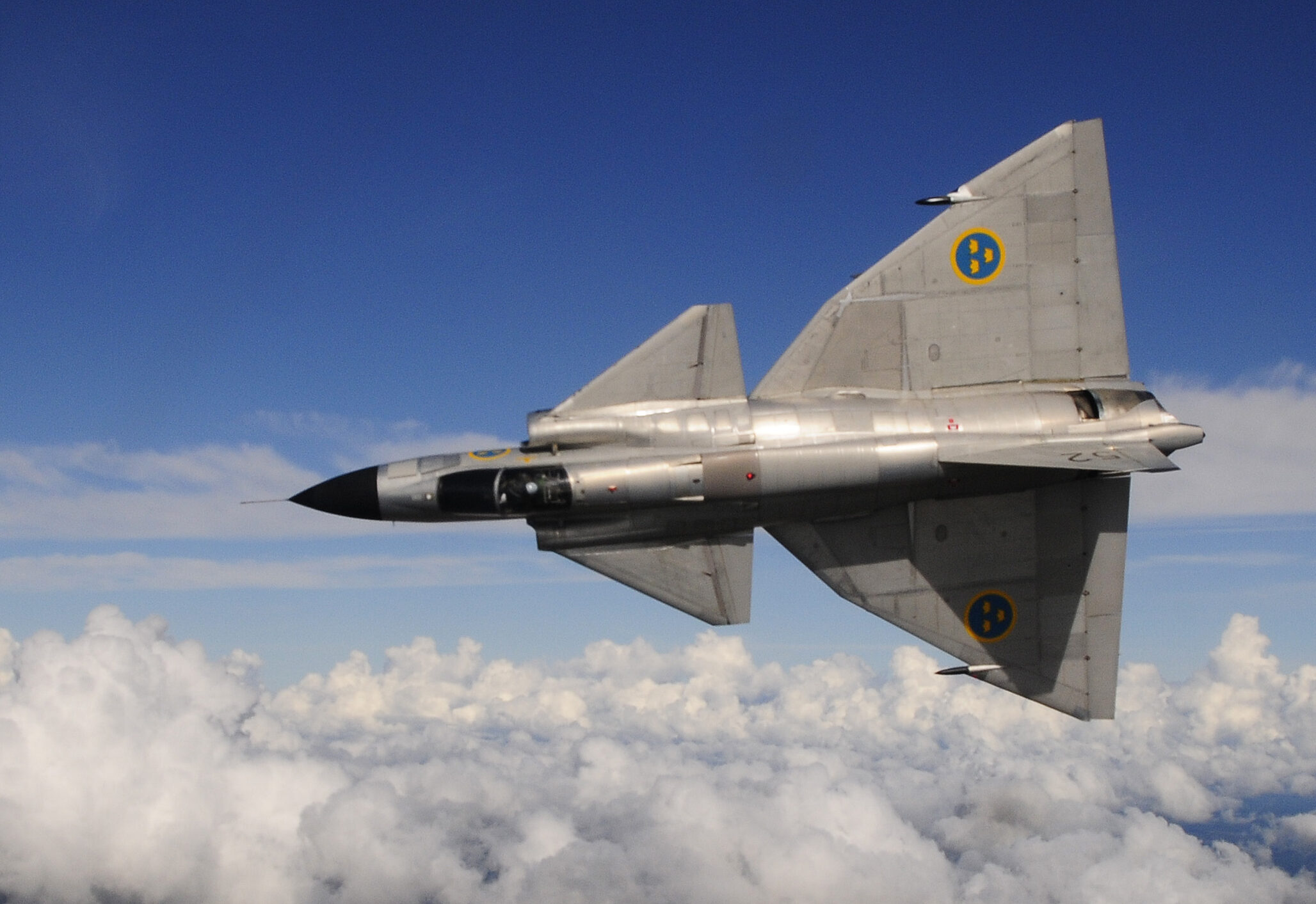
| First flight | 1973-09-11 |
| Delivered | 1974-02-04 |
| Last Flight in SwAF | 2007-09-04 |
AJS 37 Viggen has been restored to flying condition, and it’s operated by the Swedish Air Force Historic Flight (SwAFHF) at F 7 Såtenäs. In order to be able to show the Viggen outside Sweden, it has been allocated civil registration SE-DXN. No modifications were needed to get the Viggen flying as a civil aircraft, only a GPS a modern radio has been mounted in the cockpit to ease navigation and communication.
Fin numbers: F 15 Söderhamn: 31, F 7 Såtenäs: 52, F 7 SwAFHF: 52
In Swedish language the word Viggen means the flash of lightning accompanied by a crash of thunder which was created by Thor, the Norse god, when he struck his hammer. Often Viggen is translated into Thunderbolt.
Technical specification
Length: 16.3 m
Wingspan main: 10.6 m
Wingspan canards: 5.45 m
Height: 5.81 m
Empty weight: 10569 kg
Takeoff weight: 15525 kg
Power plant: RM8A. 6690 kp and 11790 kp with afterburner Zone III max.
Internal fuel: 4476 kg
External fuel tank: 1013 kg
Service ceiling: 20000 m
Take off speed: 200-310 km/h
Max airspeed: Mach 2 or 1350 indicated.
Range: Internal fuel 1700 km external tank 2100 km
Max allowed G: 6 G during peacetime.
Armament
- M/55 canon pods 30mm Aden Mk 4 with 150 rounds (two of them)
- M/70 rocked pods. Six Bofors 135 mm unguided rockets with different warheads. (Four of them)
- Rb04E Active radar homing anti-ship missile. Range 35 km all-weather capability.
- Rb15F Long range anti-shipping missile. Turbo jet. It could maneuver through sophisticated attack profiles and was highly resistant to jamming.
- Rb05A Air-to-ground missile (radio-commanded missile. The pilot guided the missile with a side-stick controller in the cockpit)
- RB75 (AGM-65A Maverick). Medium range TV-guided air-to-ground missile
- M/71 Multiple fragmentation bombs (total 16 bombs 120 kg)
- M771 Lepus 80 kg illumination bombs used for illuminating targets at night.
- Rb 24 and Rb 74 Sidewinder IR
- Bk 90 stand-off munitions dispenser. 24 launch tubes.
- BT53 Laser reflector pod
- U22 Jamming pod.
- KB dispenser pods for self-defense (Shaff and flares)
- Centerline station: 1500-liter fuel tank
- PS-37/A Radar. Mono pulse X-band ground mapping radar. It is designed for targeting ships and in a lesser capacity, a/c. The radar is also used as a navigation aid.
History
The first Viggen prototype, serial 37-1, took to the air on 8 February 1967.
Preliminary design studies on what was eventually to become the Viggen were initiated by SAAB back in the early 1950.
The project moves forward in December 1961 when an official Swedish Government decision was taken to develop Aircraft System 37 to meet Swedish Air Force´s requirements for a new multi-role fighter, to replace both the SAAB 32 Lansen and SAAB 35 Draken in the surface attack, air defense and reconnaissance roles.
The unconventional design enabled Viggen to meet Swedish Air Forces requirements for speed of Mach 2+ at high altitude and ability to operate from 500 m runways. To keep the landing distance short SAAB developed a thrust reverser integrated with the rear fuselage, still the only one of its kind on single engine aircraf
The Volvo Flygmotor RM8A/B afterburning turbofan was chosen as powerplant for the Viggen. This was a heavily modified license-built version of the civil Pratt & Whitney JT8D used on airliners such as Douglas DC-9 and Boeing 727
A total of 337 Viggen airframes were eventually constructed by SAAB in different versions designed to perform fighter, attack, recce, and trainer missions.
Viggen type designations reflected their operational roles as follows:
AJ for surface attack with secondary air defense role
SK for conversion training
SH for recce, sea surveillance
SF for recce, photographic
JA for Air defense with secondary surface attack role.
In March 1967 only six weeks after the first flight of the Viggen prototype the Swedish Government decided to order an initial batch of 100 a/c. The order comprised of 83 AJ37 and 17 SK 37 to replace the SAAB 32 Lansen in the surface attack role.
A year later the order was increased by another 74 a/c.
The first series production AJ 37 was handed over to Swedish Air Force at SAAB Linköping on 21 June 1971, and deliveries of the first generation Viggen were running until 1 February 1980.
The AJ 37 was optimized for surface attack and carry a large and varied weapons load on seven hard point under wings and fuselage. Maximum weapons load was an impressive 7 tons, compared to the a/c weight of approx. 12 tons.
Viggen conversion training of Swedish Air Force operational units was initiated by an instructor group in January 1973, with 2nd squadron of F7 Wing Såtenäs being the first unit to convert.
During 1974-75 three AJ 37 crashed due to serious wing collapse, while on operational Swedish Air Force missions. All Viggen flying was stopped for six months, during which extensive investigations made it clear that main wing spar was not strong enough to withstand the high performance of the Viggen. The thickness of metal in the reinforced wing spar was increased from 12 to 41 mm.
When Viggen deliveries to Swedish Air Force operational units started in 1973 the a/c were initially left unpainted giving them a natural metal look. In early 1974 Swedish Air Force introduced the characteristic splinter camouflage on the Viggen.
It was a highly effective camouflage in Swedish conditions, consisting of a broken pattern of three tons of green and one tone of brown.
During 1991-97 Swedish Air Force carried out an upgrade program to convert AJ/SH/SF Viggens into a common AJS 37 standard. The modification program provided first-generation Viggen airframes with an integrated attack, fighter and recce capability, resulting in a true multi-role Viggen version.
With AJS 37 the Viggen gained the capability to carry new advanced air-to-surface weaponry systems originally acquired for the JAS 39 Gripen, such as the Rb15F anti-shipping missile and Bk90 stand-off munitions dispenser.
48 of the AJ37 became AJS 37, 25 SH became AJSH 37 and 13 SF became AJSF.
SK37E SE-DXO (37809)
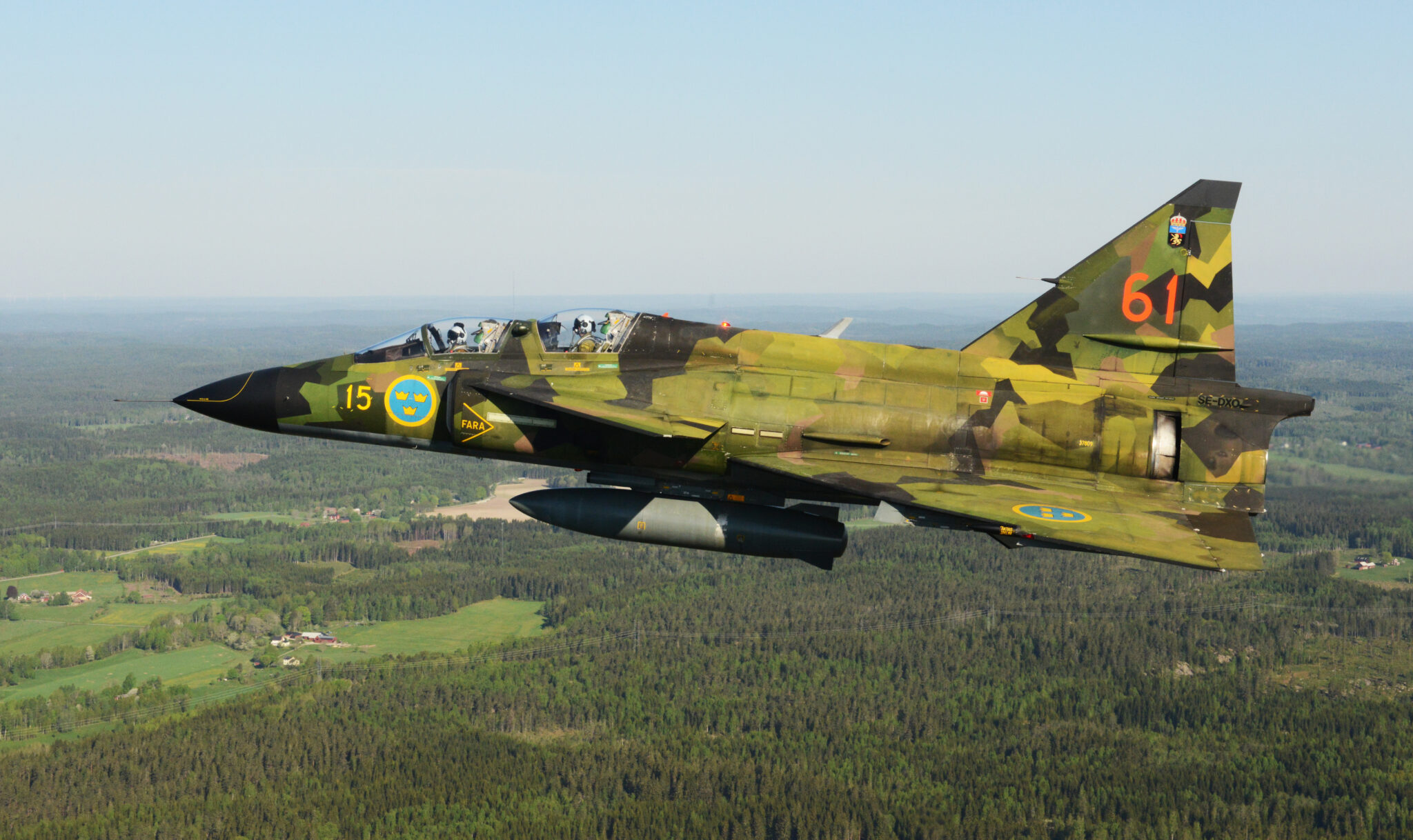
| First flight | 1973-09-11 |
| Delivered | 1974-02-04 |
| Last Flight in SwAF | 2007-09-04 |
| SK 37E modification | 2000-01-27 |
SK 37E Viggen has been restored to flying condition, and it’s operated by the Swedish Air Force Historic Flight (SwAFHF) at F 7 Såtenäs. In order to be able to show the Viggen outside Sweden, it has been allocated civil registration SE-DXO. No modifications were needed to get the Viggen flying as a civil aircraft, only a GPS a modern radio has been mounted in the cockpit to ease navigation and communication.
| Location | Fin number |
| F 7 Såtenäs | 61 |
| F 7 Såtenäs | 42 |
| F 15 Söderhamn | 61 |
| F 4 Frösön | 72 |
| F 21 Luleå | 72 |
| F 15 Söderhamn | 61 |
| SwAFHF | 61 |
The first two-seat Viggen made its first flight on July 1970. The SK37 trainer was designed simply by adding an extra cockpit of the single seat Viggen, giving the two seater a very distinctive configuration with two separate canopies.
To make room for the rear cockpit the internal fuel capacity had to be reduced and also some avionics had to be relocated to the nose Radom, resulting in the radar having to be removed. To compensate for the larger vertical area of the second canopy the tailfin area was increased by adding a 30 cm extension on the top of the tailfin as well as giving it a “saw tooth” leading edge, whereby yaw stability was maintained. The SK 37 was a pure conversion trainer with only very limited weapons delivery capability, mainly due to lack of radar. It was cleared to carry m/55 cannon pods and m/70 rocket pods for weapons delivery training purposes. Without radar it relied on Doppler and DME for navigation.
A second rear cockpit was designed in a slightly raised position with its own wind-blast screen, and to further improve forward visibility a pair of periscopes were installed on each side of fairing between the two canopies.
During 1998-200 the Air Force carried out a comprehensive to convert 10 SK37 airframes into SK37E Electronic Warfare aggressors (jammer Viggen), taking over the EW training role of the J32E Lansen.
SK37E electronic warfare equipment comprised various internal systems as well as pod mounted systems. Modifications made to the airframe included installation of nose mounted G 24 radar jammer covering S- and C-bands, Apparat 27L radar warning receivers positioned in the bullet fairings on the wing leading edges and the rear fuselage above the engine exhaust, FR31 radio in the rear cockpit to allow the EW operator to communicate independently of the pilot, GPS receiver integrated with existing navigation systems and MIL-STD 1553B digital data bus. A new instrument panel was installed in the rear cockpit, replacing most of the flying instruments with controls for the different EW systems.
The new and old rear panels were interchangeable, giving the SK37E a dual role capability of Electronic warfare and type conversion. SK37E could also carry the U95 active jammer pod. This new and highly advanced jamming pod covering X-bands was controlled by the EW operator in the rear cockpit. SK37E could also carry the U22 an older automatic responsive jamming pod.
The BT53 laser reflector pod was often carried by the SK37E during SAM exercises.
The SK37E was tasked with EW training for Swedish Air Force, army and navy units as well as operational EW support for Air Force fighter units on combat missions. When on EW training missions the SK37E used its advanced jamming systems to simulate a realistic ECM environment for surface or airborne systems. It could operate either as an EW aggressor or target, usually flying alone or in pairs. When on operational EW support missions the SK37E typically would escort packages of fighters, providing a general background jamming aimed at reducing the effectiveness of enemy radar systems and/or jamming specific targets by masking techniques in order to confuse enemy radars.
Through participation in multi-national exercises outside Sweden the SK37E proved its EW capabilities. The SK37E performed very well in this exercise and quickly earned the nickname “the terrorists” due to very effective jamming systems.
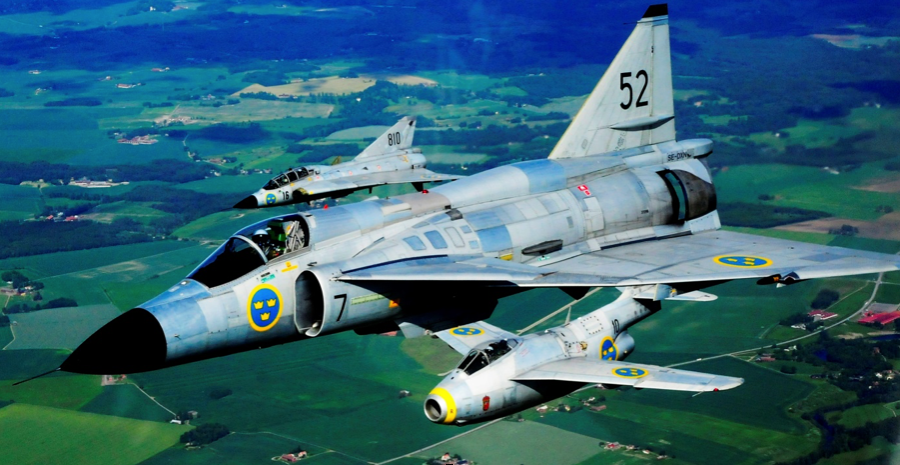
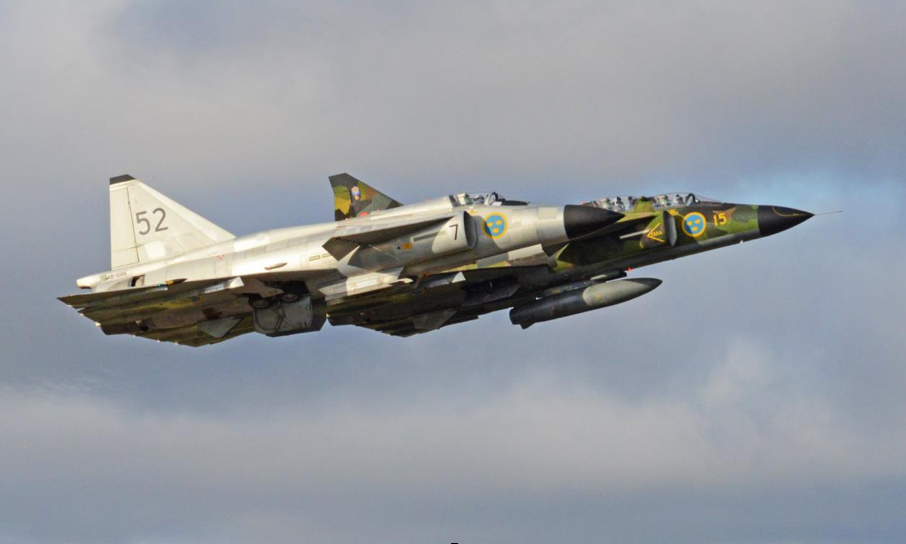
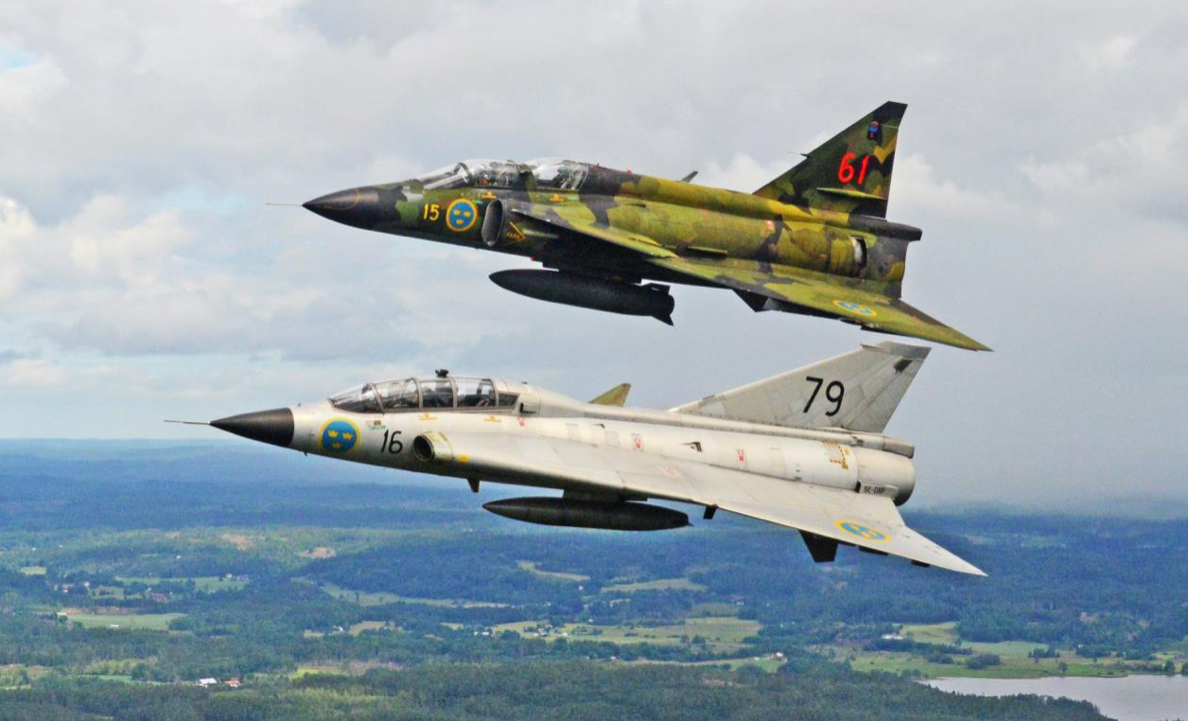

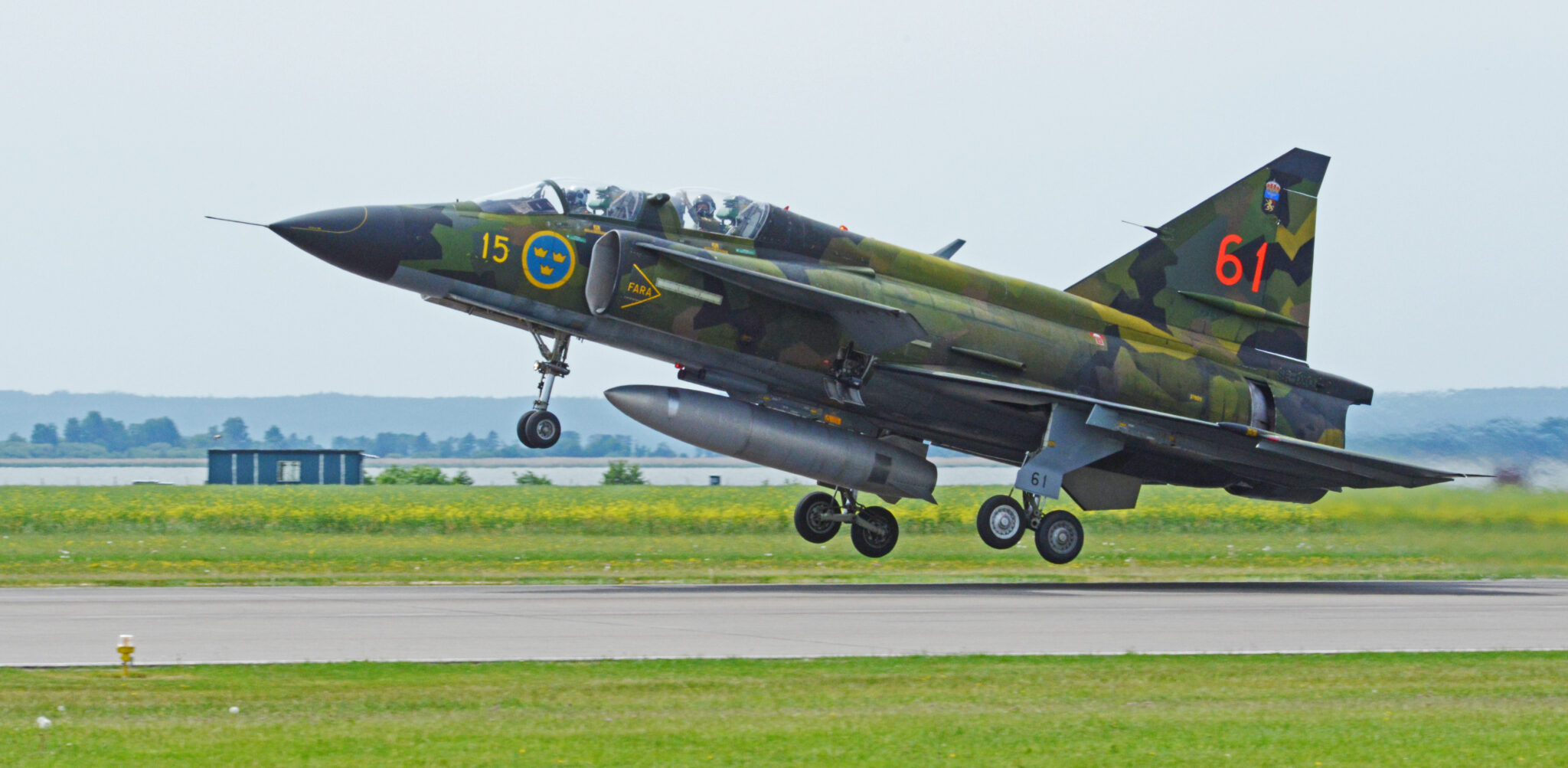
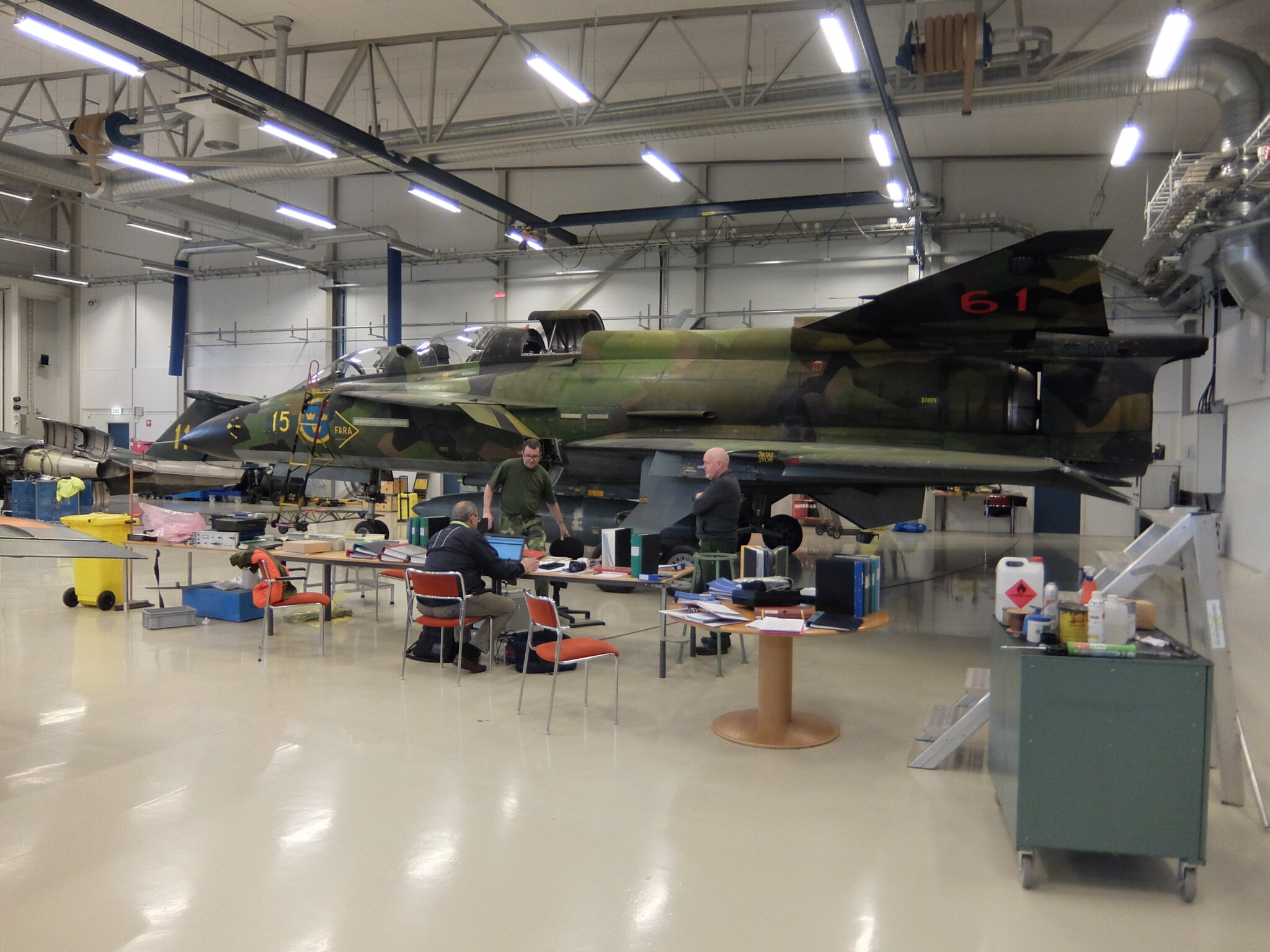
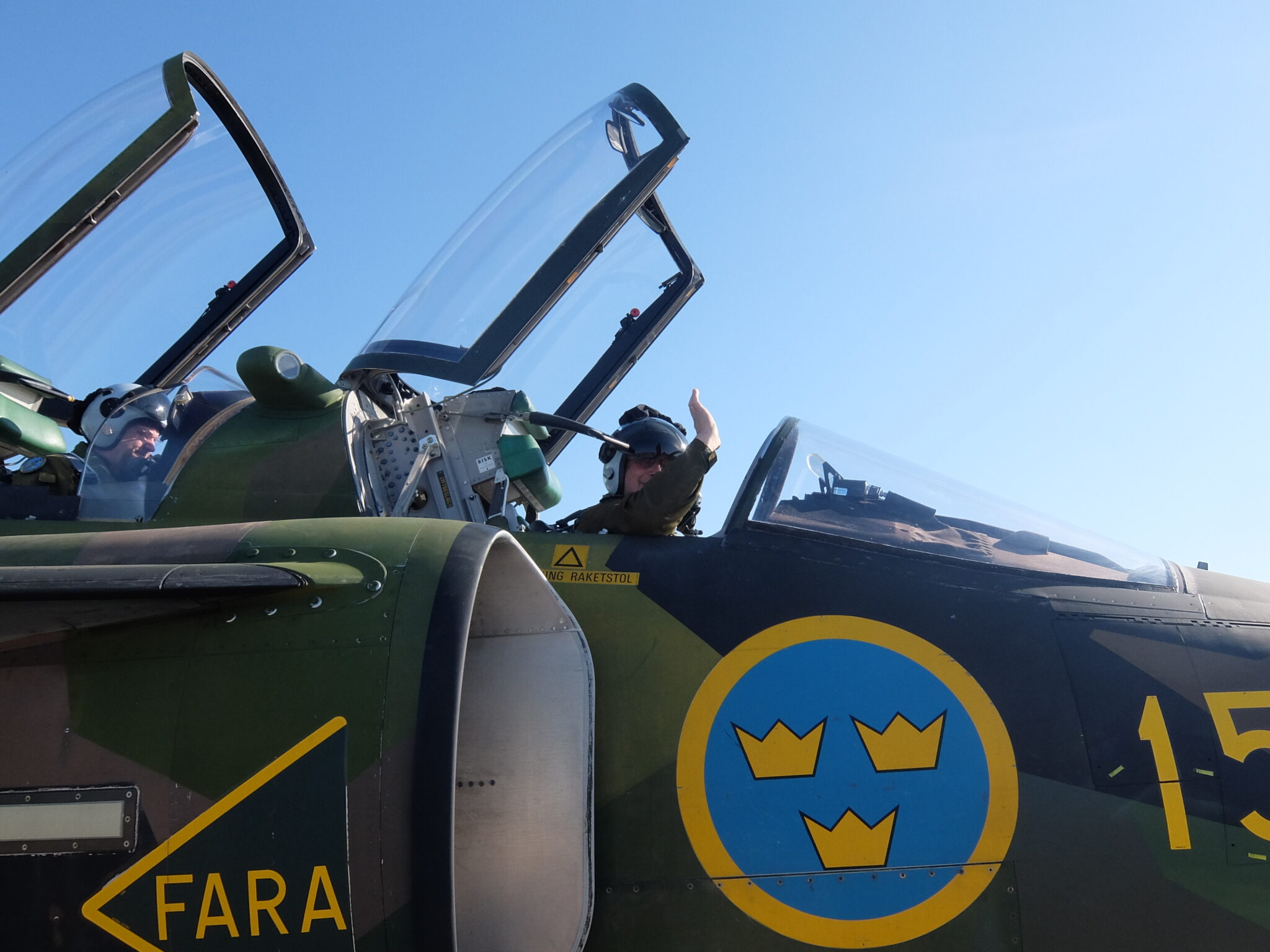
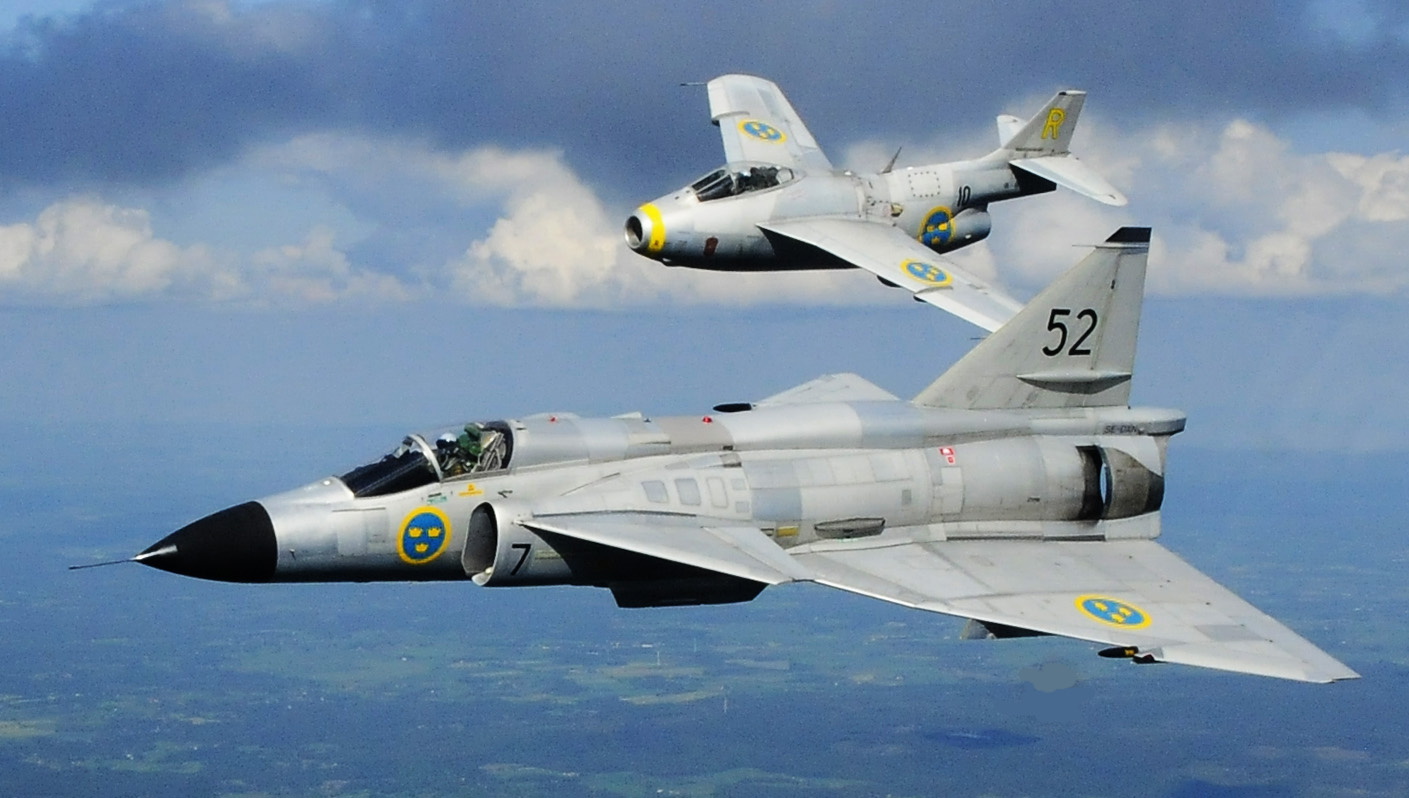
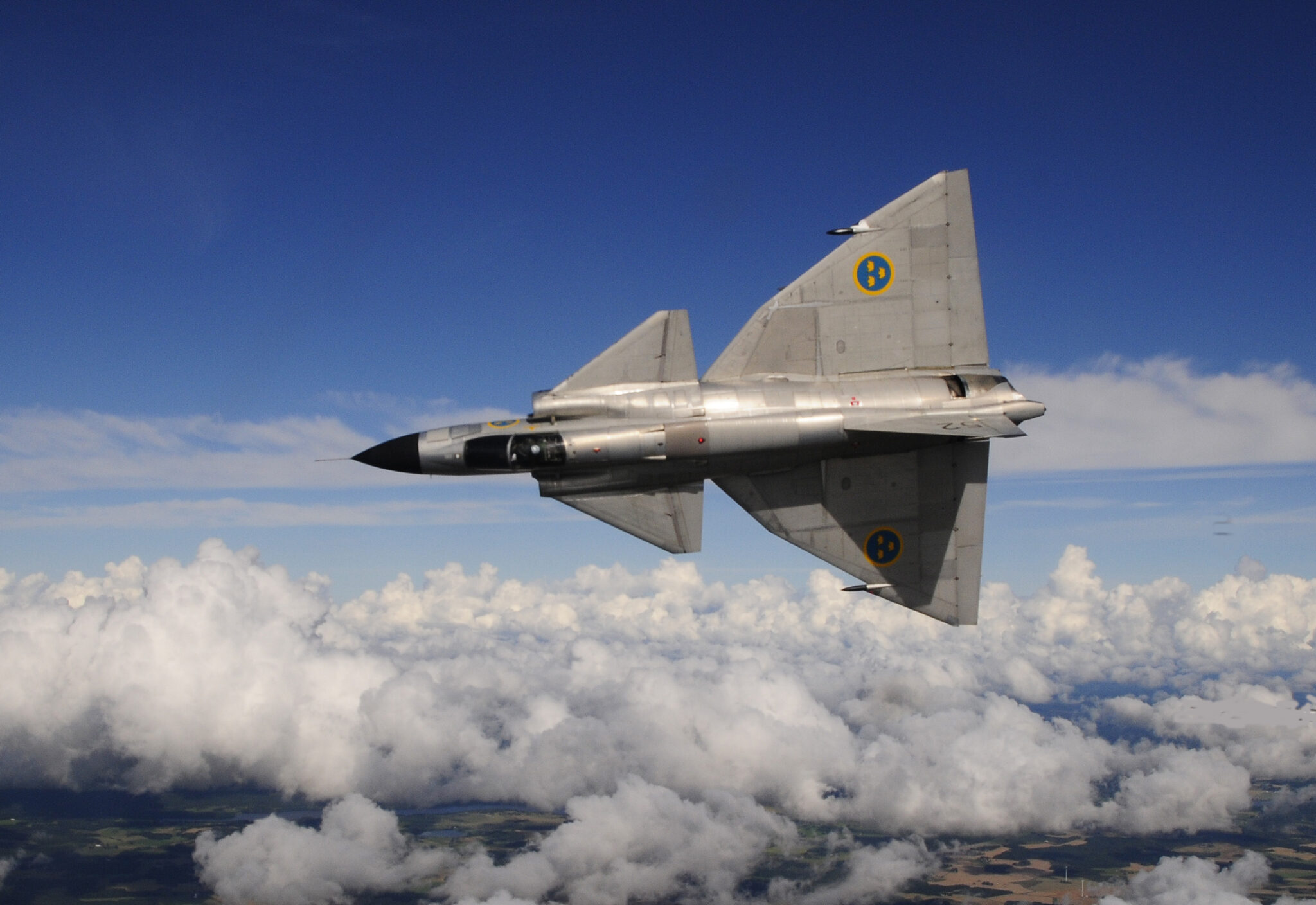
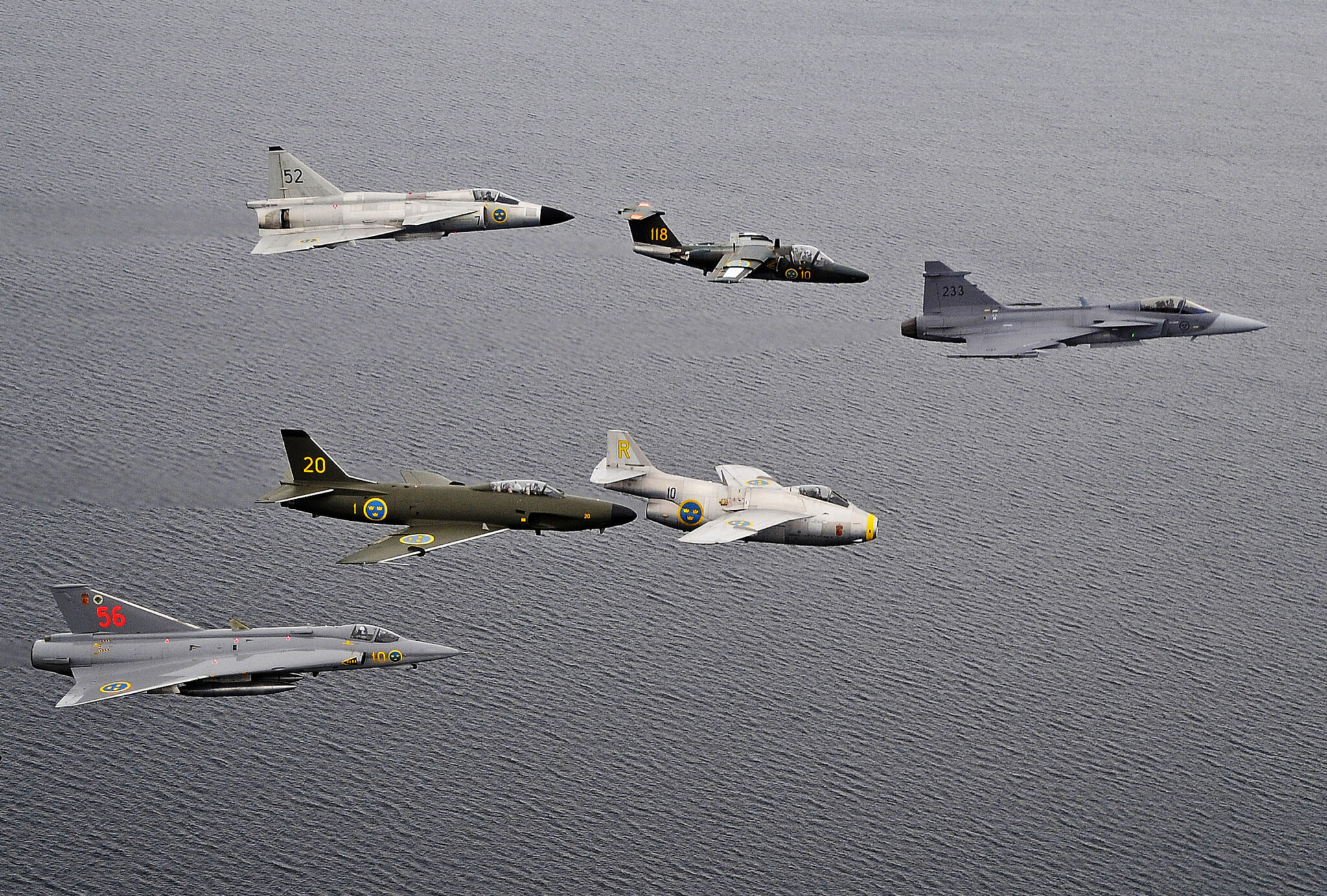
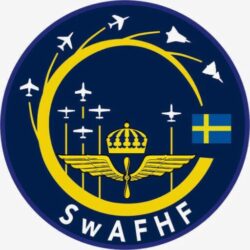
Du måste vara inloggad för att kunna skicka en kommentar.